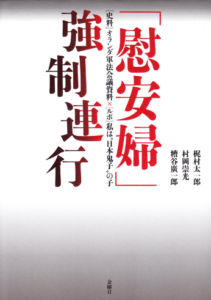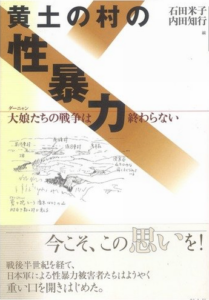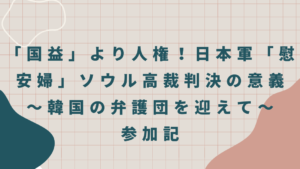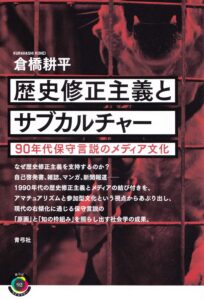Prime Minister Abe Shinzo says that there wasn’t “coercion” that no “authorities entered houses by force and took person like kidnappers” (Budget Committee of the upper house of the Diet, March 5th, 2007). And Osaka city mayor Hashimoto Toru also says that there isn’t evidence that “comfort women” were taken “by the military by means of assault or intimidation” (News conference, August 21st, 2012). Is this true?
About Korea and Taiwan which was a colony of Japan, see other Q&A. In China, Southeast Asia and the Pacific region, many cases in which the military authorities took the women using assault or intimidation are confirmed. Let’s see typical cases.
1 Speaking about China, a case in Meng prefecture, Shanxi province, came to court. In “Sexual violence in ocher village” (Sodosha), concrete details of the case are revealed by professor emeritus of Okayama University, Ishida Yoneko, and professor of Daito Bunka University, Uchida Tomoyuki. In this case, local small units of the Japanese military took local residents and imprisoned and raped them for a certain period of time. The research succeeded in revealing details of the harm through not only hearing from victimized women but also gathering many testimonials from local residents.
This case resulted in 3 lawsuits. Despite dismissing the claim, the court acknowledged the facts. The case is summarized as follows. The first one is a judgment by the Tokyo High Court in the 1st damages lawsuit by Chinese “comfort women” (July 28th, 2004). The Tokyo High Court acknowledged the facts as follows.
The Japanese North China Area Army suffered large damage from a big counterattack by the 8th Route Army in August, 1940. To deal with this counterattack, the North China Area Army carried out a cleanup, destructive and blockade strategy thoroughly from that year to 1942 (the so-called ‘Three Alls Strategy’), and among them were atrocities against Chinese people by members of the Japanese military. Under such circumstances, there were incidents of members of the Japanese military forcibly abducting, imprisoning Chinese women (including girls) living near military posts and repeatedly raping them on a daily basis, making them so-called comfort women.
It is clearly acknowledged that 4 women including Li Xiu Mei in Shanxi province, China, were imprisoned and raped by Japanese military units.
The second cases relate to judgments by the Tokyo District Court (March 29th, 2002) and Tokyo High Court (March 18th, 2005) in a 2nd lawsuit. The Tokyo District Court acknowledged that Japanese soldiers and the Qing Xiang Unit (Chinese militia cooperating with the Japanese military) attacked a village and violently abducted, imprisoned and raped the plaintiffs, Guo Xi Cui and Hou Qiao Lian in Shanxi province in 1942 (Ms. Guo was abducted, imprisoned and raped also twice afterwards.). The Tokyo High Court upheld this acknowledgement. Although the Supreme Court dismissed the plaintiffs’ final appeal, it acknowledged the fact that Japanese soldiers and the Qing Xiang Unit violently abducted, imprisoned and raped the plaintiffs.
The third cases relate to judgments by the Tokyo District Court (April 24th, 2003) and Tokyo High Court (March 31st, 2005) on sexual assault lawsuits for damages etc., in Shanxi province. The plaintiffs were 10 women including Wan Ai Hua in Shanxi province. The Tokyo District Court acknowledged the circumstances of sexual assault from late 1940 to early 1944 almost exactly as the plaintiffs argued. The Tokyo High Court upheld this acknowledgement.
In a judgment by the Tokyo High Court (March 26th, 2009) on a wartime sexual assault lawsuit for damages on Hainan Island in relation to an incident involving 8 women being imprisoned and raped by the Japanese military, it was acknowledged that “They coerced or intimidated the women using military power and did all they could to commit sexual assault to satisfy their sexual desires”.
Although not constituting abduction by the military, there is a Tokyo court Judgment in a case of kidnapping by the military. In this Judgment, the case from China is described as follows.
During the occupation of Guilin, the Japanese military committed all kinds of atrocities such as rapes and robberies. With the excuse that factories were going to be established, they enlisted factory girls. These enlisted women were coerced to prostitute for the Japanese military.
This is kidnapping by the military.
2 In Indonesia, there are many cases (The following description is based on the “Report of Study of Dutch Government Documents on the Forced Prostitution of Dutch Women in the Dutch East Indies during the Japanese Occupation”. Translation of this report is contained in, edited by Kajimura Taichiro etc., “The forced company of “comfort women””, Kinyobi).
The first one is the Semarang comfort women incident. In February, 1944, at least 24 women were taken from 3 detention camps near Semarang to Semarang and coerced to prostitute. After that, 2 female fugitives were arrested by police officers and brought back. 1 woman was hospitalized in a mental hospital, and 1 woman was forced to attempt suicide. 1 woman became pregnant and had an abortion.
The second case is the Magelang incident. In January, 1944, the Japanese military and police took women from a Munchiran detention camp, suppressing a riot by residents in the camp opposing it. Some of them were sent back, and “applicants” were sent in return. It is described that the remaining 13 women were taken to Magelang and coerced to prostitute.
The third case is that in April, 1944, the military police and police arrested hundreds of women in Semarang, selected some of them for the Semarang club (the military comfort station) and transported 20 women to Surabaya. It is described that 17 of them were transported to the military comfort station in Flores Island and coerced to prostitute.
The fourth case involves a military police commissioned officer and police in Situbondo who issued an order to obtain 4 European women. It is described that the women were taken to a hotel in Bondowoso and raped for 2 days, and 2 of them attempted suicide.
The fifth case was in October, 1943, a military police commissioned officer took 4 other women to a hotel in Bondowoso. It is described that 8 other women were taken.
The sixth case is an incident in Malang. It is described that according to a woman’s testimony, the military police in Malang imprisoned 3 European women and coerced them into prostitution.
The seventh case is an attempted incident. It is described that the Japanese military tried to take women form the Solo detention camp in Java Island, but this attempt was prevented by the leaders of the detention camp.
The eighth case is an incident in Padang. From around November, 1943, the Japanese military tried to take 25 women form Padang detention camp to Fort de Kock. It is described that although the leaders of the detention camp firmly refused, 11 women were “persuaded”, thinking that nothing could be worse than staying in the detention camp. Considering the terrible and desperate circumstances in the detention camp such as extreme shortages of food, their decisions can’t be regarded as being made of their own free will.
The ninth case is the incident in Blora, Java Island. At least 15 women were imprisoned in 2 houses and raped by Japanese military personnel.

The front cover of “The forced company of “comfort women”―Dutch Court Martial’s materials ”
The Dutch Government says that there existed at least these number of cases, going on documentary records.
It seems that harms suffered by white people are the main forms of harm described, and that an extremely narrow interpretation of what constitutes coercion is understood. Still, even limiting the discussion to abductions committed directly by the military, so many cases are actually described in the documentary materials.
Next, let’s look at the cases in which Indonesians suffered harms. From March, 1945, the 25th special base force of the Navy forcibly took local women in Ambon Island and forced them to work. Sakabe Yasumasa, who was an accountant officer attached to the force, recollected those days as follows:
Staff M……made a proposal that 4 clubs (comfort stations) be made in the north, south, east and west of Ambon and some 100 comfort women be locally supplied. The plan was to issue a proclamation in Malay in each towns and villages that “Women who committed adultery with Japanese soldiers would be strictly punished”, encourage to provide secret information, make local police officers search for women who committed adultery with Japanese soldiers, detain them in a designated building, and make some of them who are beautiful and aren’t sick work at each clubs as comfort women. During this comfort women hunting, people like us who is in love with local women was too scared to walk in the night.

The front cover of “Sexual violence in ocher village”
They are glad to go steady with Japanese soldiers. Still, no matter how much money they will make or how many goods they will have, they can’t be glad to be coerced to provide sex to many and unspecified soldiers in where they are forcibly detained. Sometimes I felt gloomy to hear the voices of young Indonesian women crying and shouting in a club. (Edited by Publication Committee on a collection of compositions by the 10th remedial class of the Navy school of accounting, “Somei”, the said Committee)
It is clear that the military committed abductions in Ambon Island.
Another example is found in evidentiary material submitted to the International Military Tribunal for the Far East. According to this material, a Lieutenant of the Japanese Army who was a commander in Moa Island, Indonesia, acknowledged that residents were executed for the reason that they attacked the military police and 5 daughters of them were forcibly taken to a “brothel”. The following is part of a statement (Doc. No.5591, edited by Utsumi Aiko etc., “The Tokyo Trial――material relating to sexual violence”, Gendaishiryoshuppan).
Q: A witness testified that you raped women and the women were taken to a barracks and raped by Japanese. Is that true?
A: I made a brothel for the soldiers, and I myself used this.
Q: Did they readily agree to be taken to the brothel?
A: Some of them readily agreed, and others didn’t.
Q: How many women were there in the brothel?
A: 6.
Q: How many of them were forcibly taken to the brothel?
A: 5.
Q: Why were the women forcibly taken to the brothel?
A: Because they were daughters of people who attacked the military police.
3 The overwhelming majority of women who came forward in the Philippines were abducted, imprisoned and raped by the military. A typical example is a testimony by Maria Rosa Luna Henson. Fujime Yuki, Associate professor at Osaka University, wrote down carefully what she heard and wrote them up in a book, “A recollection of the Japanese military “comfort woman”” (Iwanami Shoten, Publishers). According to this book, she was abducted by the Japanese military when walking on the road and imprisoned and raped for a period of time. Such cases happened very often in the Philippines.




